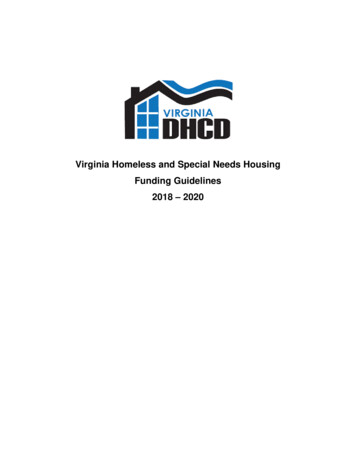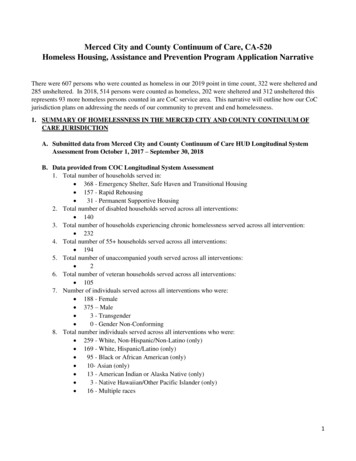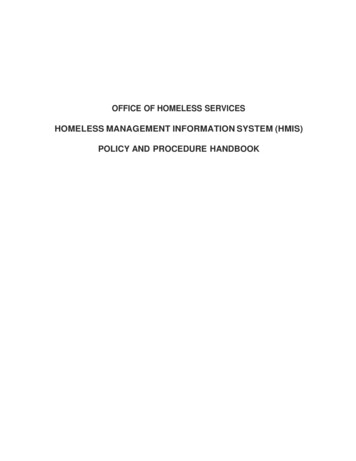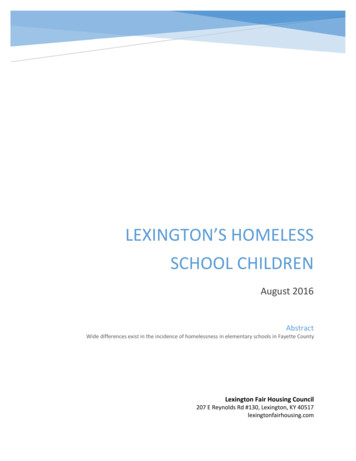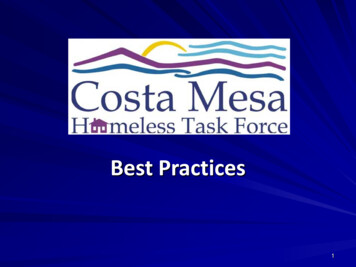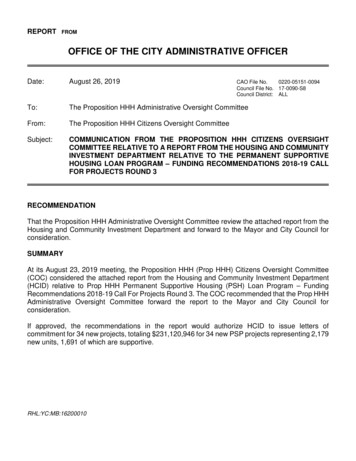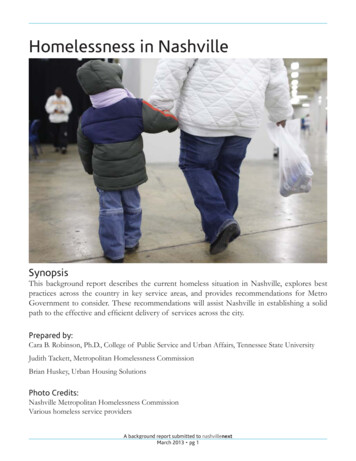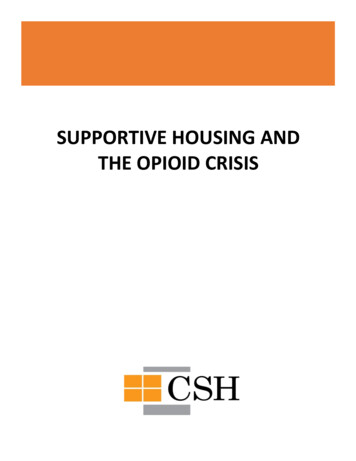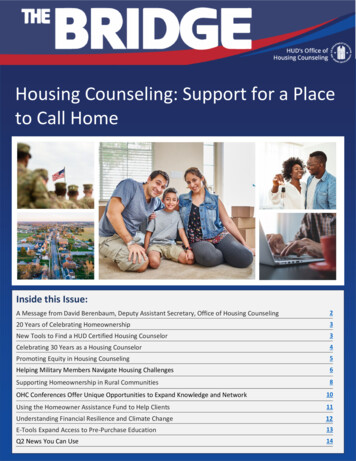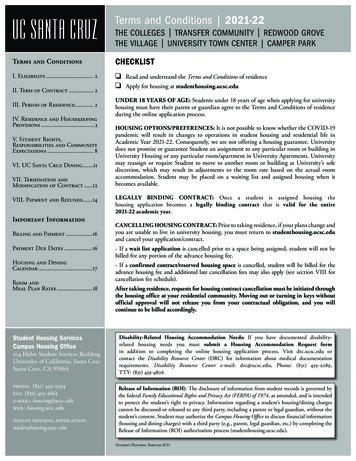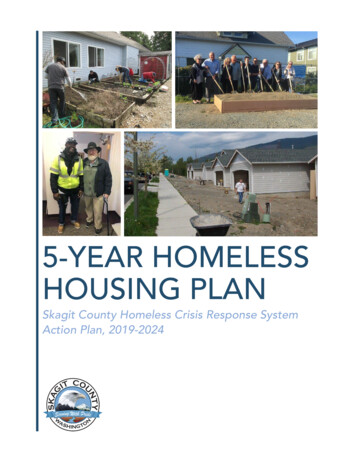
Transcription
5-YEAR HOMELESSHOUSING PLANSkagit County Homeless Crisis Response SystemAction Plan, 2019-2024
CONTENTSACKNOWLEDGMENTS . . . . . . . . . . . . . . . . . . . . . . . . . . . . . . . . . . . . . . . . . . . . . . . . . . . . . . . . . . . . . 3EXECUTIVE SUMMARY . . . . . . . . . . . . . . . . . . . . . . . . . . . . . . . . . . . . . . . . . . . . . . . . . . . . . . . . . . . . . . 4INTRODUCTION . . . . . . . . . . . . . . . . . . . . . . . . . . . . . . . . . . . . . . . . . . . . . . . . . . . . . . . . . . . . . . . . . . 6Work Plan . . . . . . . . . . . . . . . . . . . . . . . . . . . . . . . . . . . . . . . . . . . . . . . . . . . . . . . . . . . . . . . . . . . 6Purpose . . . . . . . . . . . . . . . . . . . . . . . . . . . . . . . . . . . . . . . . . . . . . . . . . . . . . . . . . . . . . . . . . . . . 6Plan Background . . . . . . . . . . . . . . . . . . . . . . . . . . . . . . . . . . . . . . . . . . . . . . . . . . . . . . . . . . . . . 7Scope of Homelessness in Skagit County . . . . . . . . . . . . . . . . . . . . . . . . . . . . . . . . . . . . . . . . . . 8Roles & Responsibilities of the System . . . . . . . . . . . . . . . . . . . . . . . . . . . . . . . . . . . . . . . . . . . . 9PLAN OBJECTIVES . . . . . . . . . . . . . . . . . . . . . . . . . . . . . . . . . . . . . . . . . . . . . . . . . . . . . . . . . . . . . . . . 10Funding Sources . . . . . . . . . . . . . . . . . . . . . . . . . . . . . . . . . . . . . . . . . . . . . . . . . . . . . . . . . . . . . . 10Allowable Interventions . . . . . . . . . . . . . . . . . . . . . . . . . . . . . . . . . . . . . . . . . . . . . . . . . . . . . . . . 10OBJECTIVE 1. . . . . . . . . . . . . . . . . . . . . . . . . . . . . . . . . . . . . . . . . . . . . . . . . . . . . . . . . . . . . . . . . . . . . . 12How is Skagit currently identifying & engaging people experiencing homelessness? . . . . . . . 12Necessary conditions to achieve objective . . . . . . . . . . . . . . . . . . . . . . . . . . . . . . . . . . . . . . . . . 13Actions, Timelines, Measures and Responsible Parties . . . . . . . . . . . . . . . . . . . . . . . . . . . . . . . . 14OBJECTIVE 2 . . . . . . . . . . . . . . . . . . . . . . . . . . . . . . . . . . . . . . . . . . . . . . . . . . . . . . . . . . . . . . . . . . . . . 15How is Skagit currently prioritizing people with the greatest need? . . . . . . . . . . . . . . . . . . . . . 15Necessary conditions to achieve objective . . . . . . . . . . . . . . . . . . . . . . . . . . . . . . . . . . . . . . . . . 16Actions, Timelines, Measures and Responsible Parties . . . . . . . . . . . . . . . . . . . . . . . . . . . . . . . 16OBJECTIVE 3 . . . . . . . . . . . . . . . . . . . . . . . . . . . . . . . . . . . . . . . . . . . . . . . . . . . . . . . . . . . . . . . . . . . . . 17How is Skagit’s system currently operating? . . . . . . . . . . . . . . . . . . . . . . . . . . . . . . . . . . . . . . . . 17Necessary conditions to achieve objective . . . . . . . . . . . . . . . . . . . . . . . . . . . . . . . . . . . . . . . . . 19Actions, Timelines, Measures and Responsible Parties . . . . . . . . . . . . . . . . . . . . . . . . . . . . . . . . 19OBJECTIVE 4 . . . . . . . . . . . . . . . . . . . . . . . . . . . . . . . . . . . . . . . . . . . . . . . . . . . . . . . . . . . . . . . . . . . . . . 20Plan projection . . . . . . . . . . . . . . . . . . . . . . . . . . . . . . . . . . . . . . . . . . . . . . . . . . . . . . . . . . . . . . . 20OBJECTIVE 5 . . . . . . . . . . . . . . . . . . . . . . . . . . . . . . . . . . . . . . . . . . . . . . . . . . . . . . . . . . . . . . . . . . . . . . 21Necessary conditions to achieve equitable homeless services system . . . . . . . . . . . . . . . . . . . 23CONCLUSION . . . . . . . . . . . . . . . . . . . . . . . . . . . . . . . . . . . . . . . . . . . . . . . . . . . . . . . . . . . . . . . . . . . . 24System gaps & opportunities . . . . . . . . . . . . . . . . . . . . . . . . . . . . . . . . . . . . . . . . . . . . . . . . . . . 25APPENDIX A: RECOMMENDATIONS TO THE STATE & COMMERCE . . . . . . . . . . . . . . . . . . . . . . . . . 27APPENDIX B: SUMMARY OF COMMUNITY FEEDBACK . . . . . . . . . . . . . . . . . . . . . . . . . . . . . . . . . . . . 29
ACKNOWLEDGMENTSTASK FORCE MEMBERSAbby Baeslack, Concrete School DistrictAlette Ford, Swinomish Indian Tribal CommunityArlene Salt, Mount Vernon Seventh-Day AdventistChurchBeth Rasmussen, Welcome Home SkagitBrian Adams, Skagit County Parks & RecreationCarolyn Moultar, Anacortes City CouncilChristi Brua Weaver, Skagit County Public HealthCora Steinhauer, Welcome Home SkagitCurtis Steinhauer, Welcome Home SkagitDawn Lee, Swinomish Indian Tribal CommunityGregg von Fempe, Telecare CorporationJames Sanders, Mount Vernon Fire DepartmentJere Lafollette, Skagit Valley CollegeKat Lohman, Side Note ConsultKayla Schott-Bresler, Skagit CountyKevin Murphy, Skagit Council of GovernmentsKim Baker, Swinomish Indian Tribal CommunityMargaret Rojas, North Sound Behavioral HealthAdministative Services OrganizationMayor Jill Boudreau, City of Mount VernonMayor Steve Sexton, City of BurlingtonMayor Julia Johnson, City of Sedro-WoolleyMelanie Corey, Skagit County Housing AuthorityMichele Metcalf, Sauk-Suiattle Indian TribeMike Luvera, Burlington Police DepartmentRichard Brocksmith, Mount Vernon City CouncilSarah Hinman, Skagit County Public HealthStephanie Thomas, Mount Vernon School DistrictTami Michael, Skagit County Housing AuthorityTom Butler, Welcome Home SkagitVicki Stasch, Anacortes Family CenterSkagit County thanks the many individuals, organizations and groups who participated in creation of theHomeless Housing Plan through community forums, surveys, focus groups and individual conversations. Anunprecedented level of expertise from across the community went into the plan from the following entities:Anacortes Family CenterBurlington Police DepartmentCatholic Community ServicesCity of BurlingtonCity of Sedro-WoolleyCity of Mount VernonCity of AnacortesCommunity Action of Skagit CountyCommunity Partnerships & Transition SolutionsCompass HealthCoordinated EntryHousing Authority of Skagit CountyFriendship HouseMount Vernon Fire DepartmentMount Vernon Police DepartmentMount Vernon Seventh-day Adventist ChurchNorthwest Youth ServicesPioneer Human ServicesSamish Indian NationSauk-Suiattle Indian TribeSkagit Coalition to End HomelessnessSkagit CountySkagit County Population Health TrustSkagit County Public HealthSkagit Council of GovernmentsSunrise ServicesTown of ConcreteTown of HamiltonYMCA Oasis Teen Shelter, Daylight Center &Outreach ProgramWelcome Home SkagitFinally, Skagit County thanks the Technical Assistance Collective (TAC) that assisted in guiding and reviewingthe Homeless Housing Plan through the Washington State Department of Commerce (Commerce).
EXECUTIVE SUMMARYPLAN OVERVIEWFUNDING & INTERVENTIONSThe vision for the 2019 Homeless Housing Plan is thathomelessness in Skagit County is prevented, and incases when it does occur, that it is a brief, rare andone-time experience. Its purpose is to make clear theaction plan of the homeless crisis response systemover the next five years and to guide funding decisionson behalf of the County. The plan was guided by atask force of community members and developed byassessing data collected through surveys, communitymeetings, focus groups, individual interviews, statespecific tools and support from the WashingtonState Department of Commerce (Commerce) and theTechnical Assistance Collective (TAC).Skagit County’s homeless housing services aresupported through a combination of funds fromDocument Recording Fees, Consolidated HomelessGrants, 0.1% Behavioral Health Sales Tax and therecently enacted House Bill 1406. Funding for 2019amounts to just over 2 million, excluding HB 1406.This latter funding source is allocated to cities from aportion of their local sales tax, and the effects have yetto be realized as jurisdictions are still deciding how toimplement these funds.Objectives for Skagit County’s plan were determinedby Commerce’s Local Plan Guidelines. The actions,timelines, measures and responsible parties wereestablished through the various community inputsnamed above.SCOPE OF HOMELESSNESS IN SKAGITIn Skagit County, 37% of all households pay morethan they can afford for housing. This translates toapproximately 18,000 households and an average of44,000 individuals1. At least 1,700 individual adults,children and youth in our community experiencehomelessness over the course of a year2. Two of thebiggest drivers of homelessness in Skagit Countyinclude the lack of diverse housing options, especiallyaffordable housing for low- to moderate-incomefamilies, and extremely low vacancy rates for all housingtypes. Skagit County has consistently maintained oneof the worst vacancy rates in the state, with a new lowrecorded in 2019 of just 0.47%3.The following plan focuses primarily on the actionsof the homeless crisis response system. The intentof this plan is not to catalog or duplicate local effortson affordable housing. However, the homeless crisisresponse system cannot be effective without theavailability of housing. The plan relies heavily on theexpectation that additional housing capacity will beadded to the system so that people experiencinghomelessness are able to move swiftly from the crisisresponse system to stable, permanent housing.Allowable interventions that Skagit County may fundthrough the above sources, by legislative statute,include: Coordinated Entry and Assessment Services-only Interventions (such as Outreach) Diversion and Targeted Prevention Temporary Housing Interventions (such asEmergency Shelter and Transitional Housing) Permanent Housing Interventions (such as RapidRehousing and Permanent Supportive Housing)OBJECTIVE 1Quickly identify and engage all peopleexperiencing homelessness and allunaccompanied youth experiencinghomelessness through outreach andcoordination between every systemthat encounters people experiencinghomelessness:1. Coordinate entry, assessment and maintainHousing Interest Pool2. Support and collaborate with local agenciesto conduct outreach to youth and adultsexperiencing homelessness3. Coordinate with existing communitypartners to ensure people experiencinghomelessness are referred into the crisisresponse systemSKAGIT COUNTY HOMELESS HOUSING PLAN
1Estimates based on United States Census Data for SkagitCounty and the SCOG’s Skagit County Housing Inventory andTransportation Analysis Report.2Source: Homeless Management Information (HMIS) data for 2018.3Source: University of Washington Runstad Center, WashingtonState Market Report, Spring 2019.OBJECTIVE 4OBJECTIVE 2Prioritize people with the greatestneed:Project the impact of the fullyimplemented local plan:1. Screen and score households forvulnerabilities that create the greatestbarriers to housing, and regularly review andassess this processAssuming existing resources and supports,anticipated population growth and inflation, andthat the objectives of the plan are successfullyimplemented, Skagit County could see thefollowing changes in year 2024: 1,009 households housed, an increase of 54additional households 90 individuals left unsheltered at a Pointin Time Count, a reduction of 29 additionalindividuals Approximately 160,962 of additionalfunding is required annually to simply keeppace with current needs and cost inflation, or 862,113 over the next five years2. Establish Youth Coordinated Entry3. Establish Permanent Supportive Housingeligibility and referral processOBJECTIVE 3OBJECTIVE 5Operate an effective and efficient homelesscrisis response system that swiftly movespeople into stable permanent housing:1. Maintain and continuously review andassess ongoing baseline system services ofDiversion, Interim Housing, Rental Assistanceand Case Management, and PermanentSupportive Housing2. Coordinate exit from the homeless crisisresponse system to stable, permanent housing3. Establish a single-site permanent supportivehousing project in Mount Vernon withcollaboration from the City of Mount Vernonand Catholic Community Services4. Identify additional community partnersto provide additional Emergency ShelterCapacityAddress racial disparities among peopleexperiencing homelessness:Through assessment of 2018 HMIS data,Commerce’s Racial Equity tool, and censusprojection data for Skagit County, it was foundthat there is a disproportionate representationof almost all communities of color within thelocal homelessness system. There is notableoverrepresentation for Native Americans,African Americans, and the Hispanic/Latinocommunity. Skagit County has begun toaddress some of these challenges through keypartnerships, such as the housing programwith Samish Indian Nation.The objectives listed above are summaries of keyactions in the plan. Please refer to the full 5-YearHomeless Housing Plan for complete actions,timelines, measures and responsible parties.SKAGIT COUNTY HOMELESS HOUSING PLAN
INTRODUCTIONWORK PLANPURPOSESkagit County first began work on the HomelessHousing Plan update in 2017. This initial effort wasspearheaded by Public Health in collaboration withthe Steering Committee for the Skagit Coalition toEnd Homelessness. The first community forum washeld at Skagit Valley College in November 2017, apublic survey was released, and several meetings wereheld in 2018 with behavioral health organizations, lawenforcement and legal experts, East County residentsand service providers, Winter Shelter residents andother nonprofit partners. Due to feedback on theprocess from communities around the state, Commercemade changes to the timeline and guidelines forHomeless Housing Plans. These changes resulted inamended guidelines released through the end of 2018and into 2019.The vision for the 2019 Homeless Housing Plan is thathomelessness in Skagit County is prevented, and incases when it does occur, that it is a brief, rare andone-time experience.In 2019, Skagit County Public Health assembled a taskforce to guide the creation of the Homeless HousingPlan. Members included representatives from localgovernment, tribes, medical fields, law enforcement,fire departments, educational institutions, housingproviders, local coalitions, community members andpeople with lived experience of homelessness. PublicHealth held community forums in Concrete, Burlingtonand Anacortes to gather community input. Additionally,Public Health released a community survey to gatherbroad public feedback for the plan. Several coalitionsand groups provided direct feedback or participated intheir own forums. County staff also conducted severalindividual interviews with city leadership, housing andhomeless service providers, and other communityleaders. Side Note Consult assisted Skagit CountyPublic Health with the activities in 2019 and authoredthe plan draft.6 SKAGIT COUNTY HOMELESS HOUSING PLANThe purpose of Skagit County’s Homeless HousingPlan is to make clear the action plan of the homelesscrisis response system over the next five years and toguide funding decisions on behalf of the County. Thefollowing pages detail the current system, how thesystem will change between now and 2024, identifygaps and describe areas of opportunity. The plan alsonotes the additional resources and conditions requiredto house everyone experiencing homelessness. SkagitCounty hopes this plan equips the community with thetools necessary to better empathize and take actionon the crisis of homelessness to ensure no person isleft living outside.The Homeless Housing Plan is intended to complementthe work of other housing action plans, such as thoseof the County, cities and towns, Skagit Council ofGovernments, and Skagit County HOME Consortium.
PLAN BACKGROUND2012 PLAN STRATEGIES4In 2005, the Washington State Legislature passed theHomeless Housing and Assistance Act, which outlinedpolicies designed to address homelessness across thestate. The act also required counties to adopt locallydeveloped plans, at the time referred to as a “10-YearPlan to End Homelessness.” Skagit County publishedand adopted its first local plan in June 2012. Thegoals of that plan were to reduce the prevalence ofhomelessness, reduce the amount of time peoplespend in a state of homelessness, and to reducehomeless recidivism.and coordinate the process1 Centralizeof intake, assessment and referral.re-house families who become2 Rapidlyhomeless.homeless prevention assistance3 Targetto people most at risk of losinghousing.The 2012 plan was largely developed and implementedby local housing and homeless service providers. TheSteering Committee for the Skagit Coalition to EndHomelessness played an integral role in leading anddeveloping the first documented, community-wideroadmap for addressing this crisis in our community.interim housing through4 Provideemergency shelter and transitionalhousing to those who need it most.the supply of permanent and5 Increasepermanent supportive housing.As our understanding of homelessness has grownover the last several years, so have our national, state,and local responsibilities to address its challenges.Commerce and the Washington Legislature have mademany changes and updates to homeless and housinggovernance since 2012, including changes to theguidelines that inform this plan. Many of the strategiesoutlined in the 2012 10-Year Plan have been improvedupon, but no single strategy has been perfectly realized.As such, this 2019 5-Year Homeless Housing Plan willreflect many of the same strategies. It also complieswith the more comprehensive requirements for localplans now in place as established by Commerce.6 housing stability.and report progress towards7 Measuregoals.Link people to services that improvenew resources to implement8 Developthe 10-Year Plan.an advisory committee that9 Establishis accountable to the 10-Year Plan.4The full Skagit County 10-Year Plan to End Homelessness fromJuly 2012 can be found on the Skagit County website.SKAGIT COUNTY HOMELESS HOUSING PLAN 7
INTRODUCTIONSCOPE OF HOMELESSNESS IN SKAGITIn Skagit County, 37% of all households pay morethan they can afford for housing. This translates toapproximately 18,000 households and an average of44,000 individuals. At least 1,700 individual adults,children and youth in our community experiencehomelessness over the course of a year: In 2018, 1,633 adults and children sought andqualified for homeless services in Skagit Countythrough the Housing Resource Center. At the timeof their assessment, 582 households were living ina place not fit for human habitation, such as thestreet or a car5. 296 people were counted in the 2019 Point inTime Count, a nationally mandated annual countof people experiencing homelessness on onenight of the year6. 769 students in Skagit County school districtsduring the 2017-2018 school year were identified ashomeless per McKinney Vento federal definitions.Most of these students were living doubled-up7.The numbers above only represent the people whohave been documented through services or schools.There are very likely more people in our communitywho simply do not know about—or are not seeking—available services. Households are increasingly findingcreative solutions to meet their own needs as theavailable services are simply not adequate. Serviceproviders and schools report that many families arebecoming more aware of this fact, thus opting toexplore solutions within their own networks rather thanengage with services at all.The circumstances that lead people to becomehomeless are varied and frequently involve multiple,compounding factors. There are also significantexternal pressures outside of people’s individualstories that drive homelessness. Two of the biggestdrivers in Skagit County include the lack of diversehousing options, especially affordable housing forlow- to moderate-income families, and extremely lowvacancy rates for all housing types.5From 2012 to 2018, the average monthly rent in SkagitCounty has increased by 314, or 41.4%8. An increaseof 100 in median monthly rent can result in a 39%increase of homelessness in rural and suburban areas9.In 2019, the vacancy rate in Skagit County reached just0.4%—well below what is considered even a “tight”rental market—and as recently as early 2019, a 0.0%vacancy rate was recorded for all two bedroom unitsin Skagit County10. In addition to rising housing andliving costs, the last decade of construction in SkagitCounty has been one of the slowest on record11.Homeless housing funds in Skagit County, as dispersedand monitored through Public Health, totaled just over 2 million in 2019. With the current crisis responsesystem only able to house approximately one-third ofall households who seek and qualify for services, it issafe to assume that Skagit County would need to atleast triple is current funding in order to adequatelymeet the needs of people experiencing homelessnessin our community.The following plan focuses primarily on the actionsof the homeless crisis response system. Localgovernment, the for-profit and nonprofit sectors,tribes and advocates are diligently working to addressthe housing shortage in our community, and the intentof this plan is not to catalog or duplicate those efforts.However, the homeless crisis response system cannotbe effective without the availability of housing. SkagitCounty’s homeless services outcomes will not improvewithout added capacity to the housing market andspecific allocation of resources to low- to moderateincome housing. The following plan is therefore anexplanation of the activities of the homeless crisisresponse system over the next five years, but it reliesheavily on the expectation that additional housingcapacity will be added to the system so that peopleexperiencing homelessness are able to move swiftlyfrom the crisis response system to stable, permanenthousing.Source: Homeless Management Information (HMIS) data for 2018.Source: Washington State Department of Commerce 2019 Point in Time (PIT) Detailed County Results. Approximately 108 morehouseholds were identified as possibly homeless, but lacked a completed survey to be formally included in the count.7Source: Office of Superintendent of Public Instruction 2017-2018 Homeless Education Student Data.68 SKAGIT COUNTY HOMELESS HOUSING PLAN
ROLES & RESPONSIBILITIES OF THE SYSTEMU.S. Department of Housing & Urban Development(HUD): HUD promotes community-wide commitmentand support to end homelessness. HUD provides grantsto nonprofit agencies, state and local governmentsthrough an annual competition.Washington State Department of Commerce:Commerce administers several state and federalfunding sources that support homeless programsstatewide, including programs in the Office ofHomeless Youth. Commerce also manages andprovides technical assistance for the state’s HomelessManagement Information System (HMIS) to collectdata and measure system performance .Skagit County: The Board of Skagit CountyCommissioners determines allocations of homelessservices funding and assures oversight over thecommunity’s homeless crisis response system.Skagit County Public Health: The Public HealthDepartment provides the staff capacity to contract anddirectly coordinate with homeless service providersand community stakeholders as well as plan newprojects. The staff at Public Health issues Notices ofFunding Availability when homeless service fundsare allocated, monitors grantee contracts, conductsfederal, state and county reporting, and other dutiesas required by the County and the Washington StateDepartment of Commerce.Cities and Towns: The cities and towns of SkagitCounty frequently deploy public services in responseto challenges around homelessness, but they receiveand facilitate very limited homeless service funds.House Bill 1406, enacted in 2019, allows for cities toretain a portion of sales tax within their jurisdictionsto apply toward prevention of homelessness. This isthe first funding mechanism of its kind that specificallyallocates homeless service dollars to cities instead ofcounties in Washington State. As of this writing, theeffects of these funds have yet to be realized as citiesand towns are still determining their plans of action.Homeless and housing service providers: Serviceproviders range in size and type around SkagitCounty. Most agencies provide emergency shelter,case management, temporary housing assistance,transitional living, outreach, permanent supportivehousing assistance or some combination of services.Many of these agencies apply for funds throughSkagit County annually, but most employ a varietyof other funding streams such as grants, individualdonations or other contracts. There are also severalagencies around the community that do not regularlyapply for or receive funds through Skagit Countybut nevertheless deliver vital services to peopleexperiencing homelessness. These agencies wouldnot be included in the Coordinated Entry system, anobligation for all agencies who receive county funding,but are included as potential resources in discussionswith applicants at the Housing Resource Center.Housing Resource Center & Coordinated Entry:Community Action of Skagit County presently maintainsa location in Mount Vernon and a satellite locationin Concrete. The agency currently manages boththe Housing Resource Center and the CoordinatedEntry system. The Housing Resource Center is theprimary hub for housing and homeless services inSkagit County. Through the Housing Resource Center,applicants are provided resources and referrals toadditional services. Coordinated Entry is the systemby which applicants are matched to services andentered into HMIS. Additional nonprofits also serve asaccess points into the Coordinated Entry system andfrequently provide information and referrals to otherservices in and out of the system. Presently, thoseagencies include Anacortes Family Center, SamishIndian Nation, Northwest Youth Services and YMCAOasis Teen Shelter.8Source: University of Washington Runstad Center, Washington State Market Report, Fall 2018.Source: Thomas Byrne, Ellen A. Munley, Jamison D. Fargo, Ann E. Montgomery & Dennis P. Culhane (2013) “New Perspectives ofCommunity-Level Determinants of Homelessness,” Journal of Urban Affairs, 35:5.10Source: University of Washington Runstad Center, Washington State Market Report, Spring 2019.11Source: SCOG’s Skagit County Housing Inventory and Transportation Analysis Report.9SKAGIT COUNTY HOMELESS HOUSING PLAN 9
PLAN OBJECTIVESThe following objectives align with those stated in Commerce’s Local Plan Guidelines12. These objectiveswere therefore preselected, although the activities, timelines, measures and responsible parties have beendetermined by the community through the collaborative process detailed in the Work Plan above.FUNDING SOURCESFunding for homeless services varies from year to yearas sources depend on grants and tax revenue, butestimates for 2019 are included below. The fundingsources for homeless housing services in Skagit Countyinclude the following.Document Recording Fees (local): Skagit Countyis eligible for and receives fees authorized by RCW36.22.178 and RCW 36.22.179. Skagit County intendsto award funds for projects that employ strategiesestablished in the Homeless Housing Plan. Programguidelines are partially set by the Washington StateDepartment of Commerce, and Skagit County mustadhere to these guidelines in administering thisgrant. In 2019, this funding source amounted toapproximately 1.1 million.Consolidated Homeless Grant (state): Skagit Countyis a “Lead Agency” for the Consolidated HomelessGrant Program (CHG). CHG combines state homelessresources into a single grant opportunity under theadministration of the Washington State Departmentof Commerce. Program guidelines are set by theWashington State Department of Commerce, andSkagit County must adhere to these guidelines inadministering this grant. In 2019, this funding sourceamounted to approximately 750,000.0.1% Behavioral Health Sales Tax (local): SkagitCounty collects funds under RCW 82.14.460. Thesefunds must be used for the purpose of providing forthe operation or delivery of chemical dependencyor mental health treatment programs and services.Programs and services include housing and casemanagement that are components of a coordinatedchemical dependency or mental health treatmentprogram or service. In 2019, this total funding sourceamounted to approximately 750,000, with 229,000specifically allocated to homeless housing projects,such as winter shelter and rental assistance vouchers.12House Bill 1406 (local): As previously stated, thisfunding source allows cities and towns aroundWashington State to withhold a portion of sales taxto be specifically allocated to homeless preventionwithin these jurisdictions. Enacted in 2019, the effectsof these funds have yet to be realized as cities andtowns are presently deciding how to utilize them.ALLOWABLE INTERVENTIONSThe allowable interventions and services that SkagitCounty may directly fund through the sources outlinedabove, by legislative statute, include the following:Coordinated Entry and Assessment: CoordinatedEntry is the system by which homeless householdsare matched to services. Assessment occurs at intakeand provides a score that is used to determine ahousehold’s vulnerability and prioritization for services.Services-only interventions: Street outreach isa services-only strategy for engaging peopleexperiencing homelessness with the purpose ofconnecting them to emergency shelter, housing orother critical services.Diversion and targeted prevention: The diversionprocess takes place during a family’s initial contact withthe homeless response system, either at CoordinatedEntry or at the front door of an emergency shelter.Through an exploratory conversation with a trainedstaff member, families are prompted to identify safehousing options based on their own available resourcesrather than those of the homeless response system.To help ease
The vision for the 2019 Homeless Housing Plan is that homelessness in Skagit County is prevented, and in cases when it does occur, that it is a brief, rare and one-time experience. The purpose of Skagit County's Homeless Housing Plan is to make clear the action plan of the homeless crisis response system over the next five years and to
